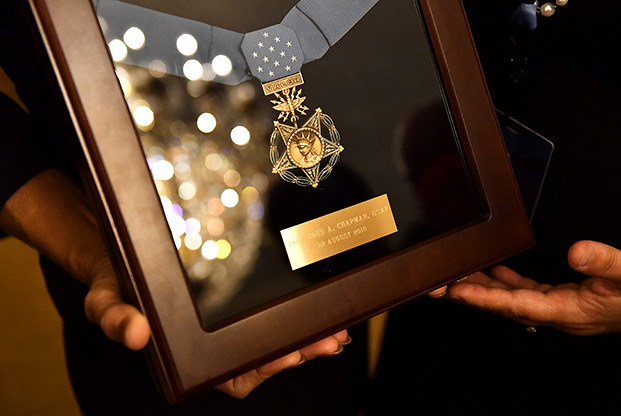
John Chapman’s Medal of Honor was presented to his widow, Valerie Nessel, at the White House on Aug. 22. Photo: SSgt. Rusty Frank
JOHN CHAPMAN’S MEDAL OF HONOR
The Medal of Honor presentation was a long time coming for TSgt. John Chapman’s family, and for the Air Force.
President Donald J. Trump on Aug. 22 awarded the nation’s highest honor for valor in combat to Chapman, posthumously, in a crowded White House ceremony. It was the first Medal of Honor awarded to an airman for actions that took place since the Vietnam War, the first for a special tactics airman, and the 19th for the Air Force.
The honor comes more than 16 years after the battle on the Afghan mountaintop where Chapman fought, alone, until his last breath to save his team. It has been more than 30 months since an Air Force investigation determined exactly how valiantly Chapman fought.
Trump presented the blue-ribbon medal, resting in a brown wooden box, to Chapman’s widow, Valerie Nessel, on what would have been their 26th wedding anniversary.
“Our nation is rich with blessings, but our greatest blessings are the patriots like John … who carry our freedom on their shoulders, march into the face of evil, and fight to their very last breath so that we can live in freedom and safety and peace,” Trump said.
On March 4, 2002, the air atop the 11,000-foot mountain of Takur Ghar was frigid, and snow was piling up to beyond knee-deep. It was the early days of the War in Afghanistan, and US special operators were deeply engaged in Operation Anaconda—an effort to find and clear al Qaeda operatives in the Shah-i-Kot Valley, in the east of the country.
Chapman’s team piled in an MH-47E Chinook, call sign Razor 3, which had its sights on Objective Ginger, a ridgeline on the mountain with a landing zone expected to be clear. At about 4:27 a.m. local time, the lumbering Chinook approached the landing zone, and concealed al Qaeda fighters opened up on it with everything they had.
Machine gun fire erupted on the helicopter and RPGs destroyed the aircraft’s hydraulic lines. The pilots veered off course and tried to regain control. In the explosions and chaos of the approach, one SEAL—Petty Officer 1st Class Neil C. Roberts—was knocked out of the helicopter and fell to the ground, surrounded by insurgents.
Razor 3 crash-landed almost five miles from its original landing zone, which was teeming with al Qaeda. Roberts, the SEAL, was left behind, his status unknown, and the team had a decision to make.
Chapman trained and fought hard and lived for his teammates, said CMSgt. Michael West, Chapman’s best friend and a former teammate. He knew the risks. Given the chance to say no and avoid danger, Chapman volunteered to get back on the helicopter and fight to retrieve Roberts.
“He could have said, ‘No, this isn’t for me.‘ But no, he was part of that team, he volunteered to go back up there,” West said.
Air Force documents described their decision to fly directly into sure enemy contact to retrieve a teammate, calling it just one measure of Chapman’s heroism that night.
The team piled into another Chinook and flew back to retrieve Roberts. This time, the helicopter was able to land and its back door slowly opened.
Insurgents were firing directly on them, and two of Chapman’s teammates were immediately killed upon exiting the helicopter.
Chapman, according to a video feed from a circling MQ-1 Predator, stormed out and directly engaged an enemy machine gun position—known as Bunker 01. He burst into the enemy’s pillbox and killed the insurgents in close-quarters combat. He then focused his fire on a second enemy position—Bunker 02—suppressing their fire and allowing his team to advance.
That’s when Chapman was shot the first of nine times.
SEALs, in cover nearby, could see Chapman’s gunsight coming out of the bunker. It rose and fell with each breath he took, slowing as time ticked by.
Eventually, at about 4:42 a.m., the sight no longer moved. The SEAL team thought Chapman had died in the bunker. The SEALs kept taking fire, and ultimately moved down the mountain. The SEAL team credited Chapman for saving their lives.
“If John hadn’t engaged the first enemy position, it would have surely killed us all before we reached cover,” one SEAL said in an after-action report.
(The initial version of his actions that night focused on everything that happened up until this point. An Air Force board at the time reviewed the evidence and voted in favor of awarding Chapman the Air Force Cross, though some added that his actions were deserving of a higher honor. One board member wrote if Chapman’s actions here did not merit the Medal of Honor, “what would?”)Minutes later, after Chapman’s team had left, he came to and continued to fight, trading fire with the enemy in Bunker 02 just meters away.
A friendly team in another position about three miles away heard fuzzy, interrupted radio calls and could make out an American voice saying Chapman’s call sign—MAKO 30C.
“I distinctly heard MAKO 30C transmitting,” another combat controller on the mission said in an after-action report. “This occurred over a 40-min period. I am absolutely positive that [it] was John’s voice. I have no doubt whatsoever. This is based on working with him for several years at the same unit.”
Friendly forces and a translator could hear the al Qaeda fighters talking about an American who was still fighting. The circling Predator and two AC-130 gunships could see infrared patches and glint tape moving in the bunker.
A quick-reaction force (QRF) jumped into another Chinook and was approaching the ridge as Chapman was firing on the insurgents. By now, the sun had risen.
Chapman, already wounded by several gunshots, emerged from the bunker and engaged an al Qaeda RPG team on a ridgeline to his right. The al Qaeda fighters in Bunker 02 remained in their position behind him. Chapman continued firing on the RPG team, limiting their effectiveness and allowing the QRF to land. In this final fight, an al Qaeda fighter shot Chapman in the back with a large-caliber machine gun.
Seventeen hours after the battle began, Chapman died on the mountaintop.
Because of the classification of the mission, the Air Force medal board at the time was only able to focus on the initial actions. In 2015, the Defense Department directed each service to identify awards cases that could merit elevation, and Chapman’s case was immediately picked. New technology greatly improved the ability to track what happened on that mountaintop.
Using pixel-tracking software, investigators were able to identify Chapman as a blurry mess of pixels and specifically track where he moved and how he fought. While viewing his action, “heroism jumps [out] at you,” and shows “the incredible sacrifice” Chapman made, said a special tactics officer who was a part of the investigation.
The team re-interviewed dozens of people involved in the initial fight. They reviewed the video feed from not only the Predator, but also video and radio traffic from the AC-130s. They reviewed Chapman’s autopsy, which showed that only two of Chapman’s nine total gunshot wounds could have been fatal, and the direction of the bullet proved he had to have been shot in his back from a position below him. All together, these sources told a story of an airman who survived to fight alone, and gave his life to protect the team on the Chinook.
“In this final act of supreme courage, John gave his life for his fellow warriors,” Trump said. “Through his extraordinary sacrifice John helped save over 20 American service members.”
The review focused on one main finding: The Air Force Cross submission was incomplete and didn’t account for everything Chapman did that day.
Chapman’s awards package rose through multiple levels, each requiring additional review, and Defense Secretary Jim Mattis eventually granted final approval for the Medal of Honor. He sent the package to the White House.
In the final approval, Mattis determined that two actions satisfied the Medal of Honor criteria: First, Chapman volunteered for the mission, where he charged into fire, seized the bunker, and moved from cover to assault the machine gun. Second, with complete disregard for his own safety, Chapman exposed himself to accurate machine gun fire to protect the quick-reaction force.
For Chapman’s family and friends, the fact that he would receive the nation’s highest honor for military selflessness isn’t a big surprise—it’s who he was.
“His whole life, he was a Medal of Honor winner, because he always put others before himself,” his mother Terry Chapman said Aug. 22.
When Chapman graduated high school in his home town of Windsor Locks, Conn., he picked an anonymous quote for his yearbook: “Give of yourself before taking of others,” Terry Chapman said.
Chapman enlisted in the Air Force two years out of high school. He had an original plan to become a combat controller, but Terry talked him out of it because of the dangers, she said. After four years working in a computer job, focusing on satellite communications, John told his mother he could not take desk work anymore. He decided to cross-train into combat control.
“He made it, and he loved it,” she said. “He said, ‘This is me.’ He was good at it.”
The award is “validation” for what John Chapman did on the mountain, said Valerie Nessel, his widow. While “it doesn’t change anything,” it proves how heroic he was. “He was there by himself, [and] he fought ‘til the end protecting his teammates,” she said.
Chapman’s former squadron commander, retired Col. Ken Rodriguez, said Chapman knew the danger he was in, but the mission, and his team’s lives, were more important.“
John would never say ‘I knew for a fact I’d never get through this,’” Rodriguez said. “John was very much, ‘I’d do whatever I can to get through this.’?”
“But he knew in his heart of hearts, I’m convinced,” Rodriguez continued. Chapman “knew what kind of danger he was exposing himself to, the enormous risk he put himself in when he struck out to defend that quick-reaction force helicopter and all the men on board.”
–BRIAN W. EVERSTINE
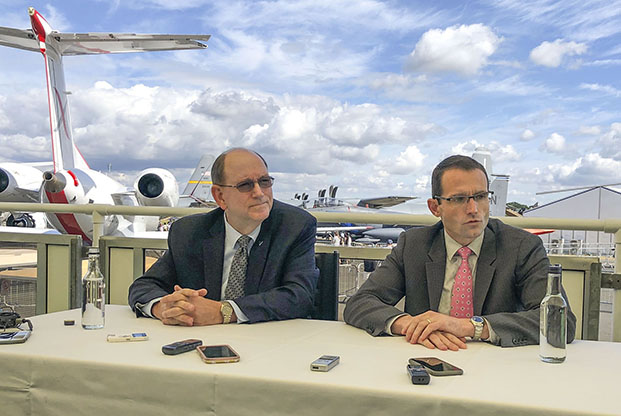
Undersecretary of the Air Force Matthew Donovan (l) and USAF assistant secretary for acquisition, technology, and logistics Will Roper answer questions at the Farnborough Air Show. Photo: Amy McCullough/staff
FARNBOROUGH AIR SHOW: SOFTWARE, NETWORKING KEY FOCUS
Farnborough, England —
As the Air Force moves toward an even more connected force that utilizes open architecture systems, artificial intelligence, and machine-to-machine learning, it must also change the way it acquires and develops those systems to ensure they are protected.
“Cyber is something you worry about every day if you do acquisition because software is in nearly everything,” Will Roper, assistant secretary of the Air Force for acquisition, technology, and logistics, told reporters at the Farnborough International Air Show in July. “It’s embedded in things that 10 years ago did not have software.”
Aircraft today have many touch points where malware can be introduced, from the diagnostic systems used by maintainers to the smart bombs hanging off the wings to the data links that enable pilots to talk to each other in the air.
That technology can also pose grave risks.
Roper said most of the conversations he’s had here at Farnborough have centered around networking, saying DOD has a lot to learn from industry on how it can improve software development—one of his top priorities.
While industry regularly looks inside its software for things that are unusual or seem out of place, the Defense Department has traditionally opted to build a perimeter to keep cyber attackers out, assuming that anyone operating inside the network had already cleared security.
“That’s probably not the right way to build a cyber defense,” said Roper. He compared it to the many once-grand castles throughout Europe that were burned to the ground, noting how the moat that had surrounded them proved to be a pretty poor defense.
Kevin Fahey, assistant secretary of defense for acquisition, told reporters those assessments will let DOD know where it should be spending money, though the work will never quite be complete. “It will be ongoing,” he said.
Fahey said there is a “concerted effort” across the department to incorporate cybersecurity into acquisition programs from the very beginning. “We’re calling it, ‘delivered uncompromised,’?” he said.
Eric Chewning, deputy assistant secretary of defense, said industry has requested—and DOD plans to provide—regular red teaming exercises to ensure industry is included in the process and there are no security gaps.
At its chalet, Raytheon had a cyber dome. Once inside you were transported into an intricate, 3-D cyber world that took the viewer inside the anatomy of a hack, providing a firsthand look at what could happen if an aircraft, or military network, was attacked.
“Everything is connected, everything is vulnerable,” cautioned one of the videos playing in the dome. That’s why the company—which is most known for its missiles—has made cybersecurity a “major focus” area.
“We deal with high-consequence mission operations and everything that goes with that,” said Todd Probert, Raytheon’s vice president of mission support modernization.
Raytheon also has a 31,000-square-foot cyber center located in Northern Virginia, where it researches vulnerabilities of platforms, systems, and software. Inside that center it also conducts training exercises for “folks working inside” air operations centers, said Michael Daly, Raytheon’s chief technology officer for cyber.
As Roper mentioned, many of Raytheon’s cybersecurity capabilities look inside the system and try to understand what’s normal and then flag what is not.
Cybersecurity is “never done. It’s constantly changing,” said Probert, who noted that Raytheon has “deployed numerous systems … across all manners of aviation platforms.”
–AMY MCCULLOUGH
DOD, LOCKHEED REACH F-35 AGREEMENT
The Pentagon and Lockheed Martin announced they have reached a “handshake deal” on the next lot of F-35 strike fighters, saying the agreement sets the stage for future cost savings through multiyear block buys.
Speaking to reporters, officials said the unit price decreased “significantly” for all three variants of the strike fighter. Although the company declined to provide a total price until the deal is finalized, Reuters reported it was worth about $13 billion.
Greg Ulmer, Lockheed Martin’s vice president and general manager for the F-35 program, said the Pentagon and Lockheed are “still working to definitize the agreement,” which will cover 141 F-35s, including 50 A-variants for the Air Force.
“Lockheed Martin is on track to reduce the cost of an F-35A to $80 million by 2020, at which point the F-35 will be equal to or less than the cost of legacy fighters, while providing a transformational leap in capability,” according to a company statement.
Production also continues to ramp up. In Lot 5, Lockheed delivered nine aircraft a year, compared to 66 last year. Ulmer said it is “on track” to deliver the scheduled 91 F-35s this year, and by LRIP 14 [Low-Rate Initial Production Lot 14] that number will grow to 145 aircraft per year. Lockheed has delivered a total of 309 aircraft to date, he added.
Lockheed, its industry partners, and the Defense Department first rolled out its “Blueprint for Affordability” in 2014, with the overall goal of getting F-35 costs to fall more in line with the cost of fourth generation fighters by 2020.
Ulmer said the first iteration generated about $4 billion of savings over the F-35’s life cycle, and there are “many hundreds of projects in the works” today associated with Blueprint for Affordability 2.
“We’re already forecasting greater than $2 billion of initial savings,” he said. “I can’t tell you there will be a Blueprint for Affordability 3 yet, but we’re having discussions with our customer about that, and that’s very much in our forefront.”
–AMY MCCULLOUGH
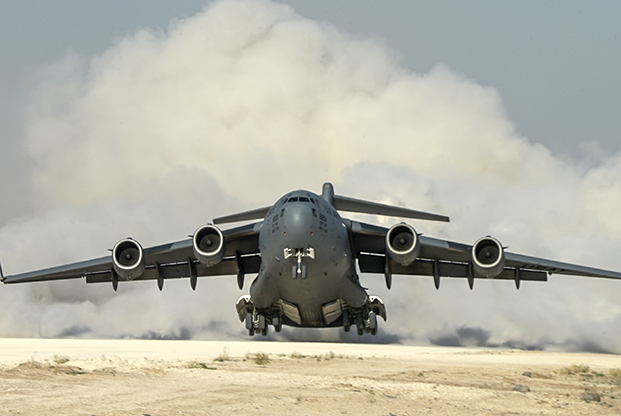
A C-17 takes off from a coalition airfield in Syria on June 26. Photo: SrA. Izabella Sullivan
BOEING RECAPTURES C-17 TRAINER CONTRACT
Boeing has won back a lucrative contract to update the Air Force’s C-17 aircrew trainer and maintenance trailer systems, a program it had lost to L-3 Link Simulation and Training back in 2010.
Ed Dolanski, president of US Government Services for Boeing Global Services, said the six-and-a-half year, $986 million contract to replace all of the Air Force’s C-17 trainers was a “very meaningful award.”
Boeing has had a performance-based logistics contract to sustain USAF’s C-17 fleet for more than a decade. During that time, the company has “reduced support dollars for aircraft by 40 percent while maintaining best in class mission capability of 81 percent or greater,” said Dolanski.
Now, with the new trainer contract, Boeing can simultaneously make modifications to both the airframe and the trainer, ensuring USAF C-17 operators always have the most up-to-date training available to them, he said.
“We paid really close attention to how we could bring value to this one. We understand the airframe very, very well,” said Dolanski. “What changed this time, is this more streamlined and agile approach to how we run services.”
In July 2017, Boeing reorganized its services division, adopting a matrix approach that brought military and commercial services together across four fundamental areas: parts supply and supply chain; engineering modifications; maintenance, training, and professional services; and data analytics.
“While we’ve maintained a consistent view to the customer, with the solutions we bring to the table now, it’s very, very easy for me to bring commercial best practices,” said Dolanski.
–AMY MCCULLOUGH
GE TO OFFER TWO OPTIONS FOR B-52 RE-ENGINING
GE Aviation plans to offer two engines in the Air Force’s B-52 re-engining program, which is finally gaining steam after decades of debate.
Speaking to reporters, company CEO David L. Joyce said GE is confident the CF34-10 engine and the more advanced Passport engine are both “good candidates” for the program.
Joyce said the Dash-10, which flies on the Embraer 190, is proven technology, with 7,000 departures every day. It’s not only “incredibly reliable,” but also the “perfect thrust size” for the B-52. However, if the service prioritizes fuel efficiency, Joyce said GE can offer the Passport, which will allow for about 14,000 hours time on wing.
“This is one of my favorite stats. If they pick the Dash-10, they get sustainability right now. That engine is performing on wing with the Embraer 190, 20,000 hours … between overhauls. If you take the 20,000 hours time on wing and put it on a B-52, the airplane might go 50 years without having to remove an engine because of deterioration,” said Joyce, emphasizing the significant cost savings that come with a commercially available motor “that’s demonstrated that level of maintainability and reliability.”
But the Passport, he says, could be equally attractive, because it would decrease the fuel burn by double digits, creating a “whole different mission profile.”
Tony Mathis, president and CEO of GE’s military systems operation, said he was encouraged by discussions at the December 2017 industry day, saying it appears the Air Force is trying to speed up the program through a rapid acquisition process.
The service’s Fiscal 2019 budget request includes $64.5 million to begin the re-engining program.
Pratt & Whitney, Rolls Royce, Northrop Grumman, United Technologies Corp., and Safran USA, also have expressed interest in the program.
–AMY MCCULLOUGH
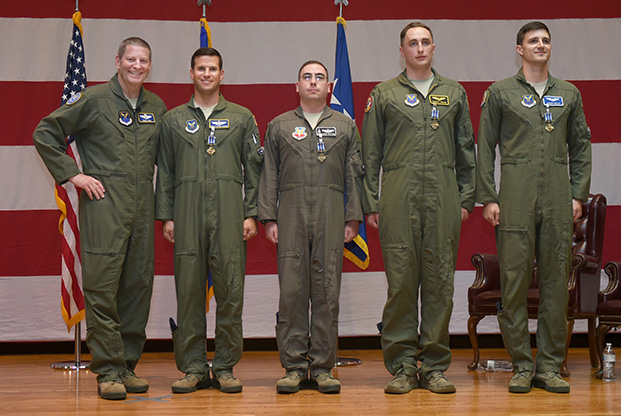
Gen. Robin Rand, left, and the B-1 crew during their Distinguished Flying Cross presentation in July at Dyess AFB, Texas.Gen. Robin Rand, left, and the B-1 crew during their Distinguished Flying Cross presentation in July at Dyess AFB, Texas. Photo: SrA. Emily Copeland
B-1 CREW AWARDED DFCS FOR ACTIONS FOLLOWING IN-FLIGHT EMERGENCY
The B-1B crew in the May emergency incident made a split-second decision to stay together and try to land their hobbled aircraft, facing the possibility of spreading fire or malfunctioning egress systems that could launch them out of the plane at any time, USAF Chief of Staff Gen. David L. Goldfein said in July.
Air Force Global Strike Command boss Gen. Robin Rand awarded Distinguished Flying Crosses to Maj. Christopher Duhon, Capt. Matthew Sutton, 1st Lt. Joseph Welch, and 1st Lt. Thomas Ahearn on July 13 for their role in the May 1 incident.
The crew was on a routine mission when their Lancer displayed three fire warnings. While they were able to extinguish two of the fires, one warning remained, and they decided to punch out. However, when one crew member pulled the handle to go, it didn’t function, Goldfein told reporters.
“They were on fire, it’s never a good thing to have a fire on an aircraft full of fuel,” he said, adding, “That young man was sitting on a live ejection seat.”
The crew then decided to remain with the plane and try to land. “You gotta think about what was in that crew’s mind, never knowing if a gust or something was going to fire them out of the aircraft,” Goldfein said. “They made the decision to stay together.”
The crew was able to land at a local airport. The investigation found that a component of the egress system was “crimped,” and when the crew member pulled the handle, the signal didn’t make it to the ejection seat. The B-1’s ejection systems have two separate ways to initiate ejection, so the Air Force allowed the Lancers to return to flight after a short stand-down and is now going through technical change orders to ensure the systems are working properly, Goldfein said.
PILOT AWARDED DFC
Maj. Michael Tolzien, of the 8th Special Operations Wing, was awarded a Distinguished Flying Cross with Valor in July for heroism as an aircraft commander in Afghanistan in January 2016.
Tolzien, the chief of current operations for the 58th Operations Group, received an alert that a special operations ground team had come under heavy fire, was isolated from conventional support, and near being overrun by enemy forces. He immediately prepared his MC-130J Commando II with needed supplies and took off.
The fighting was so intense, the airdrop location was changed a number of times, increasing pressure on the crew to determine the right release point.
Tolzien made the airdrop at critically slow airspeeds, just 800 feet above the ground. The aircraft was hit multiple times but Tolzien’s actions provided needed ammunition and medical supplies within 50 meters of the special forces team, which prevented further loss of life and “directly contributed to a successful counterattack,” the Air Force said.
Two airmen from Cannon AFB, N.M., had already been awarded DFCs for the mission.
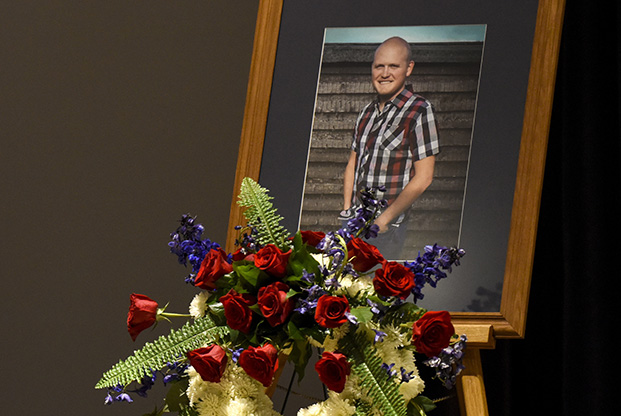
A portrait of SSgt. James Grotjan at his memorial service in early August. Photo: SSgt. Brittain Crolley
AIRMAN DIES IN INHERENT RESOLVE
An airman deployed for Operation Inherent Resolve died on July 12, reportedly after being exposed to methane gas at Al Dhafra AB, UAE.
SSgt. James T. Grotjan, 26, of Waterford, Conn., died at Landstuhl Regional Medical Center, Germany, after a “noncombat related incident” on July 8. He was assigned to the 4th Civil Engineer Squadron at Seymour-Johnson AFB, N.C.
According to a Facebook fund-raising page, Grotjan was working in a manhole underground when he was exposed to a methane gas leak. While trying to climb out, he became unconscious and fell.
THE WAR ON TERRORISM
US Central Command Operations: Freedom’s Sentinel and Inherent Resolve
As of Aug. 22, a total of 54 Americans had died in Operation Freedom’s Sentinel in Afghanistan, and 69 Americans had died in Operation Inherent Resolve in Iraq and Syria.
The total includes 119 troops and four Department of Defense civilians. Of these deaths, 53 were killed in action with the enemy while 70 died in noncombat incidents.
There have been 309 troops wounded in action during OFS and 72 troops in OIR.

